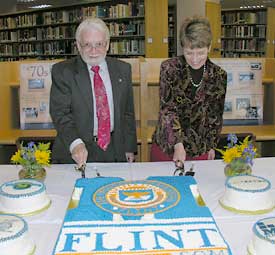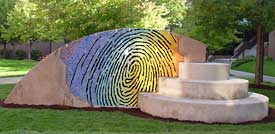U-M-Flint has turned 50—a milestone that was celebrated several times over last week by students, alumni, faculty, staff, retirees and the community.

During an official ceremony and cake-cutting Sept. 28, Chancellor Juan Mestas used a variation of the old adage “you’re only as old as you feel” to put the University’s anniversary in perspective.
“Universities don’t age like people. At 50, I knew I was old. And receiving that personalized letter from the AARP removed any lingering doubts. But I did not feel old, so I concluded that youth and old age are relative concepts that define a disposition more than a station in the space-time continuum,” Mestas said.
“Age is relative for educational institutions, too. The University of Bologna, Italy, the oldest in continuous operation, was founded in 1088. It is 918 years old. Oxford is 839 years old. Harvard is 370 years old. The University of Michigan is merely 189 years old. In university years, U-M-Flint, at 50, is just a kid. We don’t have many traditions. A tradition here is anything we do twice. Fifty years from now, when we do this celebration again, it will become a tradition.
“Traditions—we don’t have many at U-M-Flint. What we have, instead, is energy, creativity, ambition, enthusiasm, self-confidence and that pesky faith in the future inherent in the young—the young of all ages.”
President Mary Sue Coleman addressed the University’s genesis, which came about as the result of a request from the Flint Board of Education for U-M Ann Arbor to open an extension office.

“When the doors to U-M-Flint opened 50 years ago this week, it was because an entire community came together to provide a new level of education for its students,” Coleman said. “It was a genuine act of collaboration, from the philanthropy of Charles Stewart Mott and the support of Flint Junior College, to the contributions of city officials, state taxpayers and everyday citizens of Flint.
“No university in this state has stronger ties to its neighbors. That is what makes
U-M-Flint such a valuable asset, not only to Flint and Genesee County, but to the University of Michigan system. You exemplify our mission to serve the people of Michigan and beyond.”
Among those on hand for a series of celebration events were 17 members of the Class of 1958, representing 22 percent of the campuses 76 first graduates. Also helping with the celebration were two of the University’s leading Michigan-based graduates, Lt. Gov. John Cherry (master’s of public administration, 1984) and his wife, state Sen. Deb Cherry (master’s of public administration, 1993).
Lt. Gov. Cherry also praised the University for its impact on the Flint area, the state and beyond. He remarked that over its 50 years, U-M-Flint has blossomed into a full-serve campus with a unique personality that serves the cultural and educational needs of the community.
The weeklong celebration also included the screening of a film, “Women on the Edge: 50 Years of Women Breaking Academic Ground at U-M-Flint,” burial of a time capsule, free health screenings from the Urban Health and Wellness Center, and dedication of an alumni landmark.
A thumbnail fU-M-Flint history
1944: The Flint Board of Education requests that U-M open an extension office in the city
1947: The Board of Regents funds a study to explore the possibilities for higher education in Flint. Enthusiastic community response calls for a four-year liberal arts college comparable to Ann Arbor’s LSA
1956: A two-year senior college offering baccalaureate degree programs in the liberal arts and sciences and in the professional fields of education and business administration begins with approximately 167 enrollees
1964: The college expands to a four-year institution and the first freshman class of Flint College is admitted a year later
1970: the North Central Association of Colleges and Schools accredits Flint College
1971: Regents change the name to the University of Michigan-Flint, William E. Moran is named the first chancellor, and with community and city help U-M-Flint acquires 42 acres along the Flint River
1977: The campus occupies its first building (now the David M. French Hall), housing a theatre and library
1979: The University Center opens
1982: The Recreation Building opens
1988: A student parking area opens and the William R. Murchie Science Building is dedicated
1991: U-M-Flint takes possession of the University Pavilion (formerly Waterstreet Pavilion) from the city
1994: The Frances Willson Thompson Library opens
1997: The campus acquires an additional 25 acres immediately north of the Flint River, where the William S. White Building now stands (open in 2002)
1999: Current Chancellor Juan E. Mestas is appointed (and reappointed to a second five-year term in 2004)
Today: More than 400 faculty and 350 full-time staff members serve some 6,000 students enrolled in more than 100 undergraduate and 27 graduate programs

